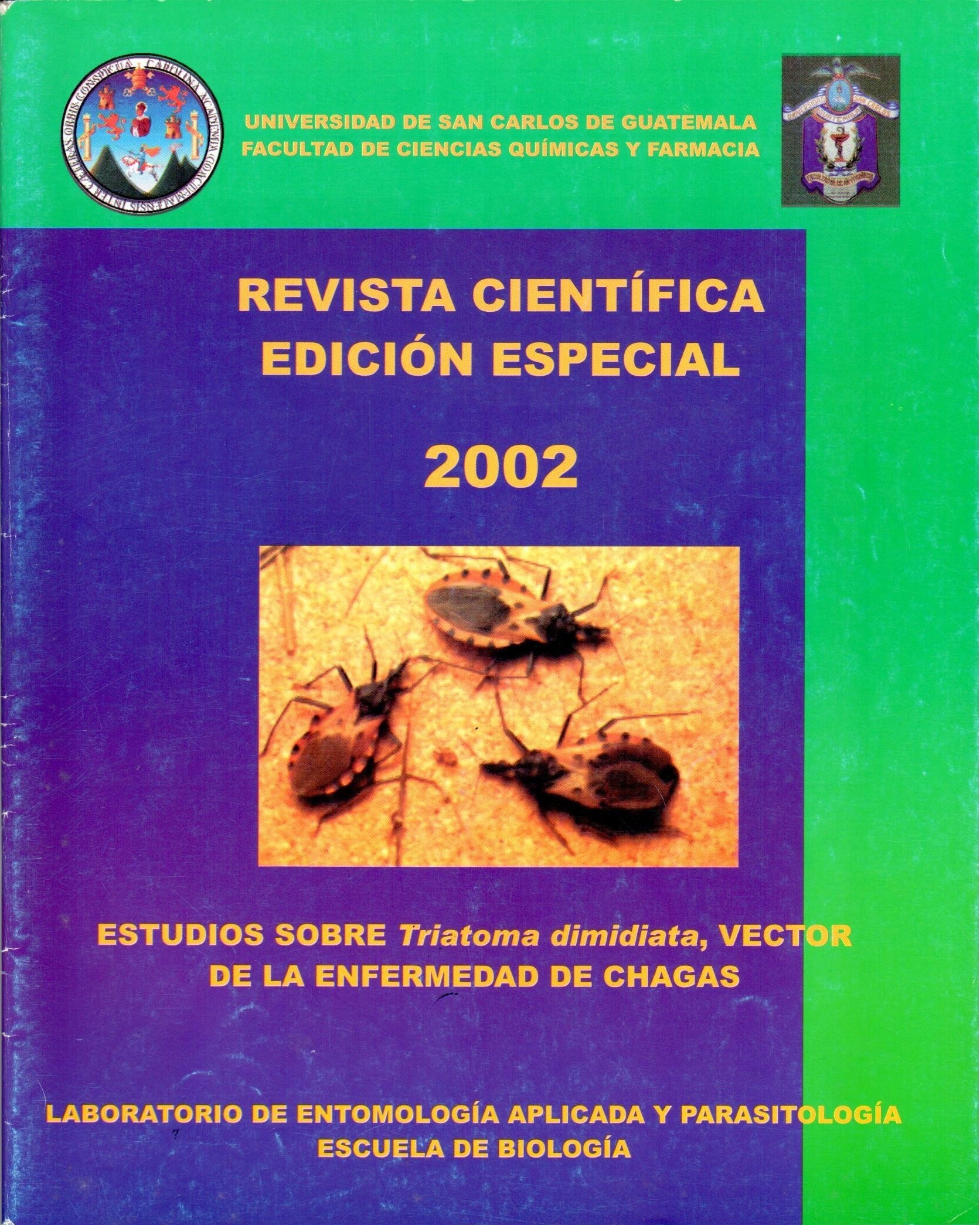Morphometric Differentiation of Rainy and Dry Season Populations of Triatoma Dimidiata (Hemiptera: Reduviidae: Triatominae), in Two Areas of Guatemala.
DOI:
https://doi.org/10.54495/Rev.Cientifica.EdicionEspecial2002.248Keywords:
Morphometric differentiation, Triatoma Dimidiata, GuatemalaAbstract
A dwelling from Agua Zarca (Ixhuatán, Santa Rosa) and another from El Cuje (Pueblo Nuevo Viñas, Santa Rosa), were selected to study the populations of Triatoma dimidiata insects they housed. In each dwelling, a group of insects collected during the hot and dry months and another collected during the rainy months were selected. These groups were compared using traditional morphometric techniques to detect possible differences between them and to analyze the nature of these differences. The El Cuje groups did not present morphometric differentiation, but the Agua Zarca groups presented a slight but significant differentiation. The results indicate that the populations of T dimidiata present movements, and that in some areas there may be at least two populations that can be differentiated morphometrically. Climatic factors such as temperature and rainfall have an influence on the start of these population movements, which can even cause populations that are not normally found in human dwellings to invade them. It is very likely that these population movements of adults occur during the hot and dry months, so this time is recommended to apply control treatments.
Downloads
References
Dujardin. JP 2000. Introducción a la Morfometría (con énfasis en Phlebotominae y Triatominae). Manuscrito Indico.
Dujardin. JP Le Pont. F. 2000. Morphometries of a neotropical sandfly subspecies. Lutzomyia carrera, thula CR. Acad. Sci. Paris, Sciences de la vie. Life Sciences 323, 273-279, https://doi.org/10.1016/S0764-4469(00)00116-5
Dujardin. JP. Forgues. G. Torrez. M. Martinez. E. Cordoba. C. Gianeila. A. 1998. Morphometncs of domestic Panstrongylus rufotuberculatus in Bolivia. Ann. Trop. Med. Par. Vol. 92, No. 2, 219-228, https://doi.org/10.1080/00034983.1998.11813283
Dujardin, JR Bermudez. H. Casini. C. Schofield. C. Tibayrenc. M. 1997. Metric Differences Between Silvatic and Domestic Triatoma infestans (Heteroptera: Reduviidae) in Bolivia. J. Med. Ehtomol. 34(5): 544-551, https://doi.org/10.1093/jmedent/34.5.544
Giojalas. LC. Catala. SS. Asin. SN. Gorla. DE. 1990. Seasonal changes in infectivity of domestic population of Triatoma infestans. Trans. Roy. Soc. Trop. Med. Hyg. 84.439-442, https://doi.org/10.1016/0035-9203(90)90355-I
Gorla. DE. Schofield. CJ. 1989. Population dynamics of Triatoma infestans under natural climatic conditions in the Argentine Chaco. Med. Vet. Ent. 3, 179-194, https://doi.org/10.1111/j.1365-2915.1989.tb00497.x
Gürtler, R. Cecere. M. Rubel. D. Schweigmann. N. 1992. Determinants of the domiciliary density of Triatoma infestans. vector of Chagas disease. Med. Vet. Ent. 6, 75-83, https://doi.org/10.1111/j.1365-2915.1992.tb00039.x
Jaramillo. N. 2000. Partición en tamaño y forma de los caracteres métricos y su interpes en los estudio pe Nacionales aplicados a los Triatominae. Tesis de Doctorado. Universidad de Antioquia. Programa de Posgrado en Ciencias Básicas B omedicas Colombia.
Klingenberg, C.P. 1996. Multivariate allometry. En Marcus, LF. Conti, M. Loy, A. Naylor. GJ. Slice. DE (editors). Advances in morphometries. NATO ASI, Series A: Life Sciences. New York, Plenum Press, vol 284, pp 23-49, https://doi.org/10.1007/978-1-4757-9083-2_3
Lehance. MJ. McEwen. PK. Whitaker. CJ. Schofield. CJ. 1992. The role of temperature and nutritional status in flight initiation by Triatoma infestans. Acta Tropica. 52. 27-38, https://doi.org/10.1016/0001-706X(92)90004-H
Schofield. CJ. 1985. Population dynamics and control of Triatoma infestans. Ann. Soc. Beige Med. Trop. 65. Suppl.1, 149-164.
Schofield. CJ. Lehane. MJ. McEwan, P. Catala. SS. Gorla. DE. 1992. Dispersive flight by Triatoma in Argentina. Med. Vet. Ent. 6, 51-56. https://doi.org/10.1111/j.1365-2915.1992.tb00035.x
Schofield, CJ. Lehane. MJ. McEwan. P. Catala. SS. Gorla. DE. 1991. Dispersive flight bv Triatoma sordid Trans. Rov. Soc. Trop. Med. Hyg. 85, 676-678, https://doi.org/10.1016/0035-9203(91)90392-C
Solis, S. 2000. Genetic variability and morphometries of Triatoma dimidiata (Latreille. 1811) geographical populations. London School of Hygiene & Tropical Medicine. Londres. Manuscrito no publicado.
Wisniviesky-Colli. C. Gürtler, R. Solarz. N. Schweigmann, N. Pietrokovsky, S. Alberti A. Flo. J. 1993. Dispersive flight and house invasion by Triatoma guasayana y Triatoma sórdida in Argentina. Mem. Inst. Oswaldo Cruz. Rio de Janeiro. Vol. 88(1): 27-32, jan/mar, https://doi.org/10.1590/S0074-02761993000100006
Downloads
Published
How to Cite
Issue
Section
License
Copyright (c) 2002 Dulce Maria Bustamante, Carlota Monroy, Antonieta Rodas, Marianela Menes, Regina Rosales, Eunice Enríquez

This work is licensed under a Creative Commons Attribution 4.0 International License.
Authors who publish with this journal agree to the following terms:
- Authors retain copyright and grant the journal right of first publication with the work simultaneously licensed under a Creative Commons Attribution License 4.0 that allows others to share the work with an acknowledgement of the work's authorship and initial publication in this journal.
- Authors are able to enter into separate, additional contractual arrangements for the non-exclusive distribution of the journal's published version of the work (e.g., post it to an institutional repository or publish it in a book), with an acknowledgement of its initial publication in this journal.
- Authors are permitted and encouraged to post their work online (e.g., in institutional repositories or on their website) prior to and during the submission process, as it can lead to productive exchanges, as well as earlier and greater citation of published work.









